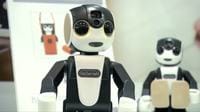Meet Pleurobot - a robotic salamander that's helping scientists unlock the complex workings of the human spinal cord.
Researchers recorded three-dimensional x-rays of real salamanders, tracking up to 64 points on the animal's skeleton.
This was then recreated in robotic form.
Professor Auke Ijspeert (pron. Aw-ka Eye-spi-ert) is leading the development at the Swiss Federal Institute of Technology.
He says Pleurobot is the most accurate robotic representation of an animal ever created.
Professor Auke Ijspeert saying:

"We could really record all these bone motions; extract that information on a computer to have all the data of the bone motion. And then make probably the robot that's the closest to an animal ever, I would say. It's really kind of unique to be able to replay as closely the walking data and the swimming data and other types of behaviour."
Ijspeert believes the salamander, which is older than the dinosaurs, is a key evolutionary creature.
Professor Auke Ijspeert saying:
"Its morphology and body shape is very close to the fossils of the first terrestrial vertebrates. So by studying the modern salamander we have a time window to the ancestors of all terrestrial vertebrates, including humans."
This makes Pleurobot ideal for testing evolutionary hypotheses, such as how the creature's ancestors evolved from aquatic to terrestrial locomotion.
It's also helping neuroscientists better understand how control signals are received by the human spinal cord.
This, they hope, could lead to the development of new therapies.
Professor Auke Ijspeert saying:
"And this type of research is very important to be the guidance research to see how you could stimulate the spinal cord, re-induce locomotion in possibly paraplegic patients in the long run. So this fundamental understanding of spinal cord functioning is very important from a medical point of view."
Pleurobot's low centre of mass and segmented legs means it could also have applications as a search and rescue robot.
The team is now working on a smaller model based on the Pleurobot that can operate on both land and in water, and is capable of navigating rough terrain.



